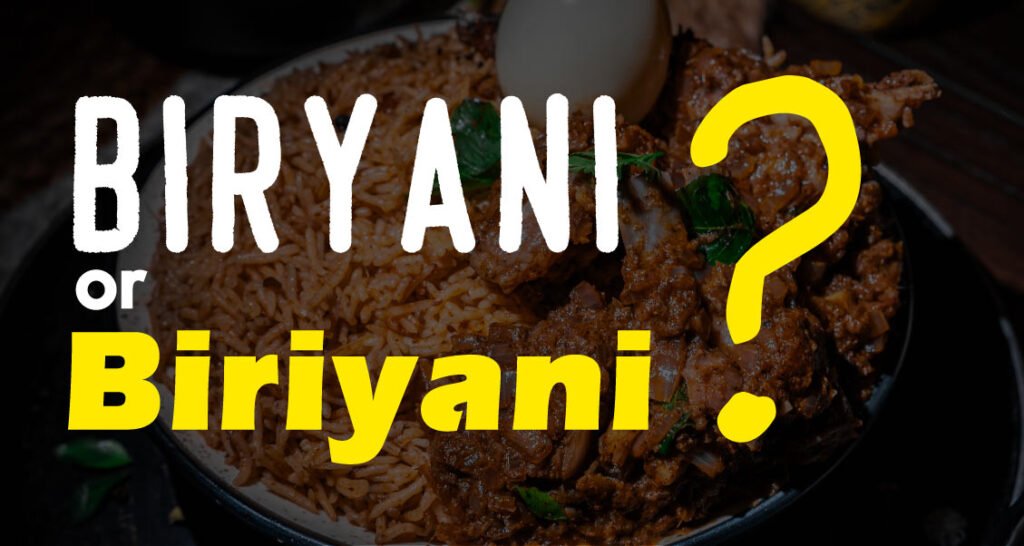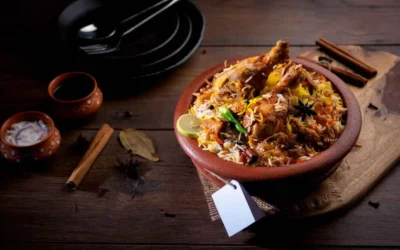Biryani or Biriyani? Understanding the Correct Spelling and Its Origins

If you’ve ever wondered whether it’s spelt “biryani” or “biriyani,” you’re not alone. The name of this iconic dish has as many spellings as it does regional variations. From “biriani“ to “biriani,“ the question of its correct spelling is as flavorful as the dish itself. Let’s dive into the word’s roots, explore its variations, and uncover why spelling matters in biryani.
The Origins of the Word “Biryani”
The term “biryani” is thought to have come from the Persian word “beryan,” which translates to “fried” or “roasted.” This makes sense, as the dish involves roasting or cooking rice with meat, spices, and aromatics to create a symphony of flavours. The Persian influence travelled to India during the Mughal era, where the dish evolved into the biryani we know today.
In Persian culinary tradition, the “beryan“ is a layered rice and meat dish often reserved for royalty. Over time, this luxurious preparation was adapted to local Indian tastes, incorporating regional spices and cooking techniques.
Spelling Variations and Regional Influences
Depending on where you are in India (or the world), you might encounter different spellings of biryani:
- Biryani: Commonly used in North India and globally, this is considered the “standard“ spelling in English.
- Biriyani: Predominantly used in South India, particularly in Tamil Nadu and Kerala.
- Biryiani: Found in some Middle Eastern and Central Asian regions.
- Biriani: A less common variation, sometimes seen in African countries like Tanzania.
- Beriani: Seen in older Persian or Urdu texts.
These variations are not just about linguistics but reflect the diverse regional takes on the dish.
Why Are There Different Spellings?
1. Linguistic Diversity
India is a land of hundreds of languages and dialects. The pronunciation and transliteration of “biryani“ naturally vary from one language to another. For example:
- In Tamil, it’s often spelt “biriyani“ to match the local pronunciation.
- In Urdu and Hindi, “biryani“ is the most common spelling.
2. Colonial Influence
During British rule, transliterations of Indian words into English were often inconsistent. This led to multiple spellings of the same word, depending on who documented it.
3. Cultural Adaptation
As biryani spread globally, each region adapted the spelling to fit its linguistic norms. For instance, “biriani“ is more common in East Africa due to Swahili influences.
Does Spelling Matter?
The spelling might seem insignificant when enjoying a plate of aromatic biryani. However, for food enthusiasts, historians, and restaurateurs, it’s a way to preserve the dish’s cultural and historical essence.
For example:
- Restaurants often choose the spelling that aligns with their regional identity (e.g., “Hyderabadi Biryani“ vs. “Thalassery Biriyani“).
- Food bloggers and writers use specific spellings to cater to local or global audiences.
Fun Facts About Biryani and Its Name
- Longest Name: The full name of some biryani varieties can be a mouthful, such as “Kacchi Hyderabadi Dum Biryani.”
- International Variants: Did you know that in Indonesia, a dish called “nasi kabuki ” is inspired by biryani?
- Different Alphabets: Biryani is written as برياني in Arabic and பிரியாணி in Tamil.
People Also Ask
Q: Which is the correct spelling, biryani or biriyani? A: Both are correct. “Biryani“ is widely used in North India and internationally, while “biriyani“ is more common in South India.
Q: Is it breyani or biryani? A: “Breyani“ is a variation of biryani, typically used in South Africa to describe a spiced rice and meat dish influenced by Indian cuisine.
Q: How do you spell breyani? A: It is spelled “breyani“ in South African English, reflecting the local adaptation of the dish.
Q: What language is biryani in English? A: The word “biryani“ in English derives from Persian, reflecting the dish’s origins and journey through Indian culinary history.
FAQs About Biryani Spelling
Q: What is the correct spelling of biryani? A: “Biryani“ is the most widely accepted spelling in English, but “biriyani“ is also correct, especially in South India.
Q: Why are there different spellings for biryani? A: The differences arise due to regional languages, cultural adaptations, and transliterations over time.
Q: Is “biryani” and “biriyani” the same dish? A: They refer to the same dish, though the recipes and preparation methods may vary by region.
Conclusion
Whether you spell it “biryani“ or “biriyani,” there’s no denying this dish unites people across cultures with its irresistible flavours. The spelling may vary, but the love for this iconic dish remains universal. So, next time you savour a plate of biryani, take a moment to appreciate not just the spices and aromas but also the rich linguistic and cultural history that brought it to your table.
Explore More About Biryani
- Ultimate Guide to Tamil Nadu-Style Biryani
- Order Authentic Biryani Online Now
- Learn About top 50 Biryani Varieties around the world
Discover more with Infinity Biryani Studio, where every plate tells a story of tradition and taste!
Author: Manish Pandey
Website: https://publicmediasolution.com/






